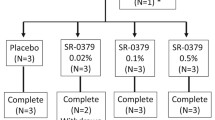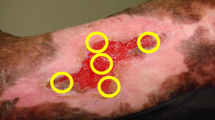Abstract
This prospective, multicenter, open-label study assessed the efficacy and tolerability of recombinant human platelet-derived growth factor BB (becaplermin) in the treatment of chronic ulcers of the lower extremities in 73 patients with and without type 2 diabetes mellitus. Becaplermin gel .01% was applied once daily for 12 weeks. Efficacy was assessed in terms of progression to healing (100% epithelialization); the secondary efficacy endpoint was time to complete healing. Safety was assessed in terms of incidence of adverse events. Ninety-five percent of all ulcers were completely healed at week 9; only 5% remained incompletely healed at week 12 and were considered treatment failures. Healing time did not differ between diabetic and nondiabetic patients. The major adverse events were pain, burning sensation, and pruritus at the ulcer site, with an overall incidence of 10%. No patients dropped out because of adverse events. Becaplermin gel .01 % was safe and well tolerated. Further studies are necessary to assess the durability of healing with this treatment.
Similar content being viewed by others
References
Callan MJ, Harper DR, Dale JJ, Ruckley CV. Chronic leg ulcers: socioeconomic aspects.Scott Med J. 1988;33:358–360.
Evans CJ, Fowkes FG, Hajivassiliou CA, et al. Epidemiology of varicose veins: a review.Int Angiol. 1994;13:263–270.
Ibrahim S, MacPherson DR, Goldhaber SZ. Chronic venous insufficiency: mechanism and management.Am Heart J. 1996;132:856–860.
Cheatle TR, Scurr JH, Coleridge Smith PD. Drug treatment of chronic venous insufficiency and venous ulceration: a review.J R Soc Med. 1991;84:354–358.
Jain KK. Pathophysiology and pharmacotherapy of chronic venous insufficiency: a critical review.J Clin Res. 1998;1:269–288.
Bennett NF, Schultz GS. Growth factors and wound healing, II: role in normal and chronic wound healing.Am J Surg. 1993;166:74–81.
Stadelman WK, Digenis AG, Tobin GR. Impediments to wound healing.Am J Surg. 1998; 176(suppl 2A):48S-54S.
Robson MC, Mustoe TA, Hundt TK. The future of recombinant growth factors in wound healing.Am J Surg. 1998;176(suppl 2A):80S-82S.
Ksander GA, Chu GH, McMullin H, et al. Transforming growth factors β1 and β2 enhance connective tissue formation in animal models of dermal wound healing by secondary intent.Ann NYAcad Sci. 1990;593:135–147.
Smiell JM, Becaplermin Studies Group. Clinical safety of becaplermin (rhPDGF-BB) gel.Am J Surg. 1998;176(suppl 2A):68S-73S.
The National Pressure Ulcer Advisory Panel. Pressure ulcers prevalence, cost and risk assessment: Consensus Development Conference statement.Decubitus. 1989;2:24–28.
Dermal wounds: pressure sores. Philosophy of the IAET.J Enterostomal Ther. 1988;15:4–17.
Ruckley CV. Socioeconomic impact of chronic venous insufficiency and leg ulcers.Angiology. 1997;48:67–69.
Robson MC. Exogenous growth factor application: effect on human wound healing.Prog Dermatol. 1996;30:1–7.
Puolakkainen PA, Twardzik DR, Ranchalis JE, et al. The enhancement in wound healing by transforming growth factor β1 (TGFβ1) depends on the topical delivery system.J Surg Res. 1995;58:321–329.
Author information
Authors and Affiliations
Rights and permissions
About this article
Cite this article
Guzman-Gardearzabal, E., Leyva-Bohorquez, G., Salas-Colín, S. et al. Treatment of chronic ulcers in the lower extremities with topical becaplermin gel .01%: A multicenter open-label study. Adv Therapy 17, 184–189 (2000). https://doi.org/10.1007/BF02850294
Issue Date:
DOI: https://doi.org/10.1007/BF02850294




